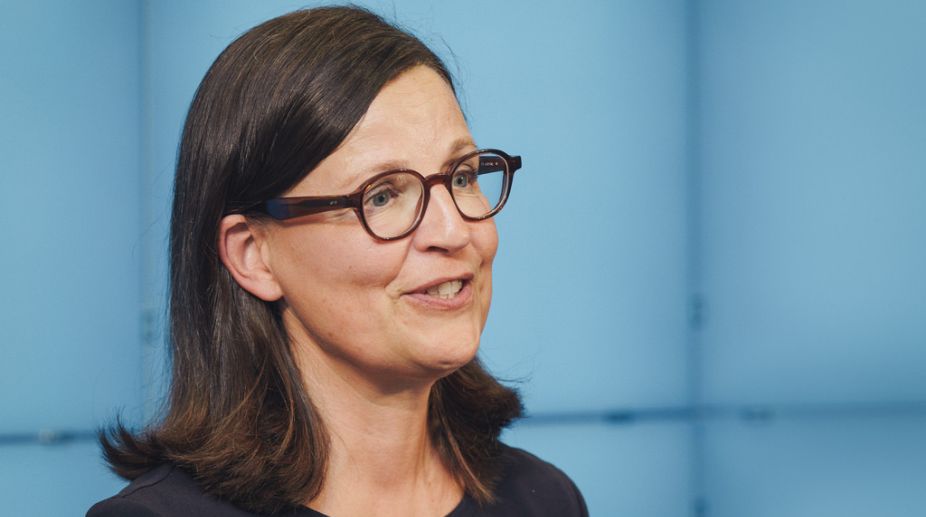Striking a balance
The National Education Policy suggests that rich Indian legacies must not only be preserved but also researched and put to new uses through education

Anna Ekstrom (Photo: Facebook)
Sweden’s Minister for upper secondary school and adult education and training, Anna Ekstrom recently paid a visit to India.During her threeday tour of India, the minister held various meetings with her Indian counterparts and other officials, and took part in a panel discussion. She launched the project Pratham, which aims to educate 30,000 school children in three states with the support of nine Swedish companies. She also visited IKEA Foundation, which, along with the United Nations Development Programme,has started the Disha project to educate one million women over a 10-year period. The minister also inaugurated the Nobel Memorial Wall at Rajiv Chowk,displaying portraits of India’s eight Nobel laureates that were made by art students from different Fine Arts universities in India. In Sweden, Ekstrom is known for taking various measures to improve vocational and adult education. A law graduate from Stockholm,the minister has a long association with education. Before becoming a minister, Ekstrom was working as Director-General,National Agency for Education. In a conversation with Rakesh Kumar the minister spoke about the importance of vocational training; Indian and Swedish education system and how in future vocational education can generate employment and help economy.
You must be aware about the working of the Indian education system. Any suggestion you would like to give for it?
Advertisement
I think the most valuable experience Indians can learn from Sweden’s education system is how to give basic education to the whole population. Basic education includes reading and writing. Another thing I would also like to suggest ~ be it Indian or Swedish students, they should have capacity and capability to learn more, even if they drop from school. Because we live in a very fast moving economy, old jobs go away and new jobs emerge. And no one knows which will be the new jobs. Therefore, one needs to learn constantly. Interestingly, we have more adult students in vocational courses than young students.
Advertisement
If we compare the education system in both countries ~ Sweden and India ~ there is a vast difference. In Sweden the stress is more on vocational while in India it is more theoretical. What is your take on it?
Yes it is…but challenges and opportunity are the same at some places. When it comes to vocational education, students in both places don’t find it attractive enough. Therefore, both Swedish and Indian industry feel the shortage of workforce. In Sweden, it is really a big problem for its economy.
How does vocational education work in Sweden? Can it be replicated in India?
I don’t believe in copying, because education is very much linked with how the economy of a country works. And there are many other issues. According to me, learning should be life-long, it shouldn’t end at school or college. One learns many things at workplace also. Another aspect I would also like to highlight is that there should be a close collaboration between schools and workplaces. For instance, if one is going to get trained for construction workers, it can’t be done in a school. One has to (be trained) at the work place, where you will work with materials, talk to your future colleagues. I think this is the best way to teach students and make them skilled.
School drop-out is a major issue in India. What is the scenario in Sweden? How is it tackled there?
Even in Sweden school dropout is a major problem. Therefore, we are focusing more on vocational studies. Even if students leave school mid-way, they should have some degree in hand. And yes, we also ensure that if they come again to join studies they should have easy access to education. We really (encourage) drop-outs to come back to the education system.
Technology is a sector where Sweden starts teaching students from a very early age. Do you think India should also do the same?
Technology can play many parts in education system of India. When a young person enters the (job) market or if a student goes to university ~ for everything technology is required. Therefore, everyone, be it kids or adults, should have knowledge of technology. We start educating about technology very early and a majority of schools in Sweden have pre-school technology education. More than 90 per cent students have access to technology in pre-school. At this age, we try to acquaint students with digital knowledge, to face digital world in future.
What opportunity does Sweden offer in terms of higher education for Indian students?
We have a large variety of Masters programme. The best part of the Swedish Masters course is that it is in English, not in Swedish. There are many options for scholarships also.
Advertisement